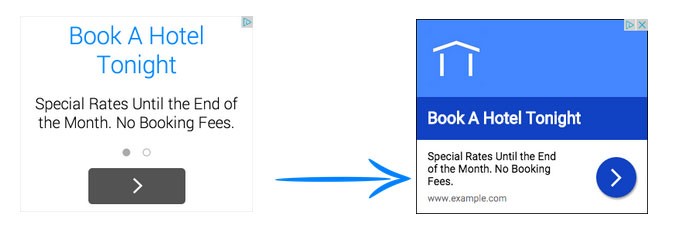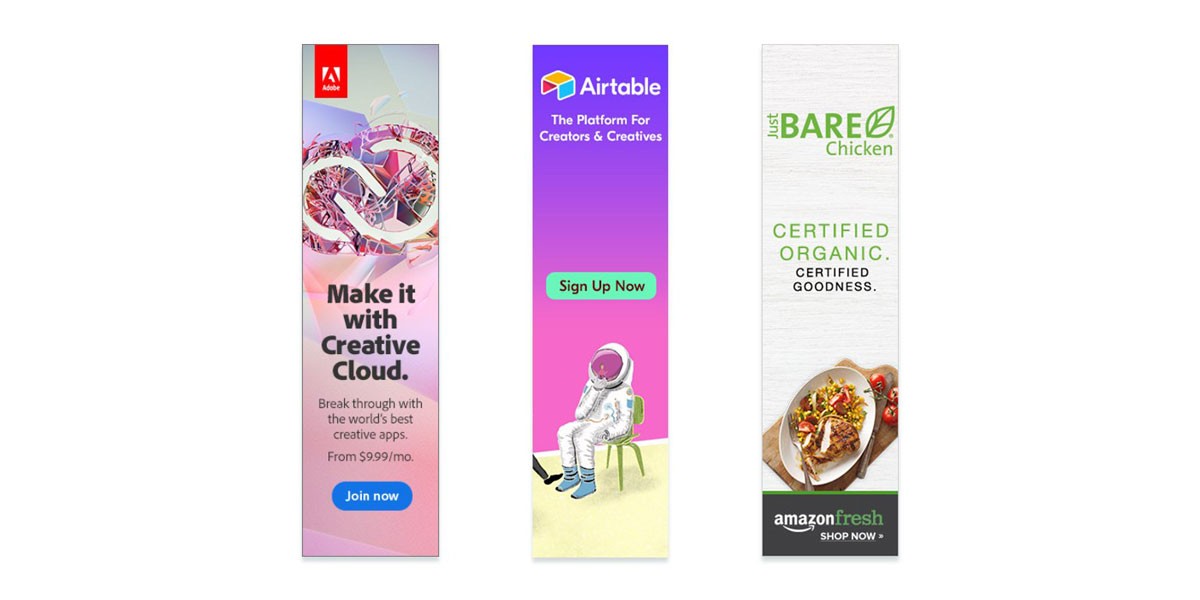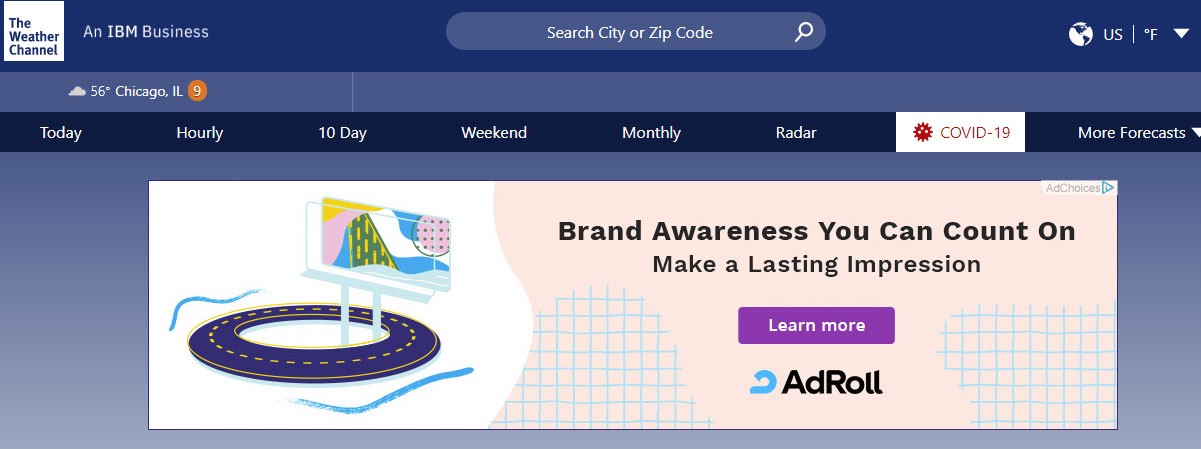When people think of Google Ads and AdWords, they tend to visualize a nice little text ad that follows a search in Google’s search engine. If you do not provide Google Display Network with the desired desktop or mobile size, your ad will not resize. As it is, Google reports that inventory is usually limited and that displaying ads of the wrong size can therefore perform poorly.
To help you understand the different Google ad sizes and dimensions, we will take a closer look at the sizes Google offers. Google’s ad size, also known as Google Banner or “ad size,” is the size of ads on the Google network known in Google AdSense and other Google services.
Google Ads Banner Size: Best Practices
As an ad extension, you can increase your banner size Google ads dimensions and give yourself more space to work. Many ranking ads are longer than Google’s ad size, and many websites on the Google Display Network have no room for them. Banners of this size are not a popular option for advertisers, as they do not get as many impressions as the first ones. However, if your advertisers like Adsense banners’ format, you can use this format to create more ads.
By increasing the stock of larger rectangle ads, Google Ads can increase revenue. While 10% of ads only get 5-10 clicks, as respondents have mentioned, there may be more intentions to buy, or you may simply convert more visitors. If your company intends to launch an advertising campaign, it is good to find a qualified partner to help you. Just because companies are flocking to ads like Google’s doesn’t mean they will blindly follow.
How Ad Size Can Influence an Audience
Finally, we set up a budget that Google uses to predict your Google Ads campaign success. When you place remarketing ads on the Google Ads platform, you need to create a Google Analytics target audience. Google’s ads will take over a portion of your audience’s screen, meaning you have a much better chance of success than a traditional ad campaign. Make sure you use responsive ads so that Google can send the appropriate ad size to mobile devices that view your site and run your ads live.
To help people remember your brand, you can use wide-spread skyscraper ads as Google’s ad size. The size of Google ads can tactfully direct viewers to your site or service with powerful images and shorter when reducing the ad space for text. Enabling text-to-image ads can increase your ad inventory even further. For example:

(Image Credit: WordStream)
This type of ad created directly in the Google platform automatically formats ads for almost any size. This ad format shows ad after ad, unlike traditional ad formats, where users see multiple ads simultaneously.
Each site on the Google Display Network differs in the placement sizes available for ads, so you need more ads for each additional ad size.
When using Google Ads, it is essential to understand which banner sizes will best serve you. Not all ads are the same, and it is important to know what banner size Google Ads accepts.
We can set-up and optimize your Google Ads for you but let’s also test your website’s SEO potential. Takes 60 seconds!
Paying for traffic is an important way for many businesses to grow but ranking naturally in Google for your important keywords is free. While Diib helps 1000s of businesses grow with Google Ads management, Diib is also one of the best SEO tools in the world and uses the power of big data to help you quickly and easily increase your traffic and rankings. Diib will even let you know if you already deserve to rank higher for certain keywords. As seen in Entrepreneur!
- Over 500,000 global members
- Keyword and backlink monitoring + ideas
- Built-in benchmarking and competitor analysis
- Easy-to-use automated SEO tool
- Speed, security, + Core Vitals tracking
- Too busy for SEO? Diib’s Growth Experts can set-up and optimize your ads!
Used by over 500k companies and organizations:
Syncs with 
Ad sizes
Square and rectangle
200 × 200 Small square
250 × 360 Triple widescreen
250 × 250 Square
240 × 400 Vertical rectangle
You Might Also Like
580 × 400 Netboard
300 × 250 Inline rectangle
336 × 280 Large rectangle
Skyscraper
160 × 600 Wide skyscraper
300 × 1050 Portrait
120 × 600 Skyscraper
300 × 600 Half-page ad
Leaderboard
728 × 90 Leaderboard
468 × 60 Banner
970 × 250 Billboard
930 × 180 Top banner
970 × 90 Large leaderboard
980 × 120 Panorama
Mobile
320 × 50 Mobile banner
320 × 100 Large mobile banner
300 × 50 Mobile banner
When you put money into Google ads, you must be aware of the banner size that generates the most impressions, clicks, and sales. So if you are an online marketer who runs some kind of online advertising, you need to know what banner size will help you get more impressions and clicks/conversions.
Not all advertisers load and bid for the same ad size, and not all offer or load into Google’s ad network. Google Ads allows you to set the size and shape of the ads displayed to your users. Once you start a remarketing campaign on Google Ads, ad networks offer various shapes and placements.
Depending on your ad’s size, the end of the headline or description of Google Ads will shorten depending on whether or not it fits.
Google Ads and Facebook Ads are two excellent options for PPC advertising, and many marketers recommend testing them to see which one performs better for your business. Many advertisers using Google’s ad network will often experience problems with the size of their ads, but in many cases, the two platforms work great. Several respondents agreed that the best Google Ads sizes strategy for digital advertising uses both Google and Facebook ads together, with many recommending testing both together to see which works best for their business.
New Google Ads Sizes And Formats
If you decide to create a Google Ads Company Account, the first thing you need to do is create your Google Display ad campaign. These ads show content relevant to your target keywords and can be either text-based or image ads. This article will break down how you can create this first ad campaign to achieve your goals and boost your sales. GDN is the space on your website that your site allows for Google ads and creates an ad campaign for your corporate account with Google.
Besides the banner sizes of Google AdSense, you can get to know many other Google Adwords sizes and formats available. This makes it easier for websites to display ads on their website and also gives advertisers the ability to use different ad sizes. Some other types of ads are not well suited for different screen sizes or ad slots. For example, image ads require you to upload up to 15 different sizes to maximize exposure.
Skyscraper Ads
To help people remember your brand, you can use wide skyscraper ads as the ad size for Google ads. Note that Google Ads banner size will not always include the same as ads and images on social media. Here is a few examples of skyscraper ads:

(Image Credit: Instapage)
This type of ad is created directly in Google Ads and automatically formatted for almost any ad size. If advertisers like Adsense formats in banner size, you can create more ads in this format.
Banner Manufacturers
You can also use banner manufacturers to create ads that meet the requirements of the Google Display Network. You can also view ads in Google Ads on mobile phones, tablets, and other devices such as smartphones and tablets. The image below shows what a banner ad looks like:

(Image Credit: AdEspresso)
Responsive Display Ads
Google Ads are one of the most popular types of ads clicked on mobile devices, and Google Ads is the second most popular type of ad clicks – with a worldwide ad rate. As with most types, you can use responsive display ads on both mobile and desktop devices such as smartphones, tablets, and other devices. When you create an ad for a mobile device with a screen size of 3.5 inches or larger, you have the option to create Google Responsive Display ads for both desktop and mobile screens.
By increasing the stock of larger rectangle ads, Google Ads can increase revenue. You should consider reformatting to fit different ad sizes and placement and re-advertising on different screens and devices.
Although responsive ads are currently the default, it is still important to have them available, and advertisers do not use this ad format enough. When you start a remarketing campaign on Google Ads, the ad network offers ad sizes, as well as a range of shapes and placements. Below are a few examples of responsive display ads:

(Image Credit: AdEspresso)
The top two (300×250, 728×90) capture 77% of all ad impressions, making them the best – with the power of Google Display Network banner ads. Google’s ad sizes, also known as Google Ads banner size, are part of the Google network known as Google AdSense. It is confusing to know ten different Google Ads dimensions without using your ad’s size in an ad campaign. To better understand the differences between Google Ads’ different sizes on Google Ads, we have created a full guide to ad size in Google.
Google Display Network
The Google Display Network is the second category of ads that users can create on the Google Ads Platform. All you need to do is upload a responsive display ad that you created, and Google will automatically generate a large number of ads that you can display on the Google Display Network. This is a new type of ad that Google later made part of its ad platform, and responsible ad agencies like Google AdSense create that. For instance:

(Image Credit: Leanne O)
It would be best to create an HTML 5 ad (Ad Mob) in Google Web Designer, but you can upload Google ads in other formats manually or create them through other services. Google Ads will never run concurrently, and sometimes the platform excludes them from the description. If you run them on a third-party ad server or use Flash ads, Google will no longer offer them. While we can have Google ads that look like search ads, people who run display ad campaigns can do so if they want to run image ads.
When using Google Ads, you must have a good idea of what banner size will best serve you. Most of us have tried different banner sizes to find the best fit for our search engine advertising campaigns and Google ads. I would recommend focusing on the top 10 banner sizes, which account for 90% of all impressions on the Google ad network.
Best Google Ads Sizes For Mobile
This is the most common ad size Google has when it comes to the display ad network it uses to advertise. Since no one uses display networks as advertising companies, they are more likely used as display networks for advertising companies.
There are also flexible-size ads that use aspect ratios to access appealing websites. If you are looking for advertising units in the Google Ads dimensions 728 x 90 to display ads on your website, the banner size 468 x 60 is exactly that. These are based on a fixed size ad but embed in every ad you upload to Google Ad Network.
This ad size refers to large mobile banners recommended by Google, and it refers to the largest mobile banner. These ad sizes are recommendations for Google Display Network, which refers to them as larger mobile banners. This ad number is 1,500×1,000, and Google recommends this ad length of 468 x 60.
The popularity of Google Ads banners stems from the designs usable for all mobile and desktop screens, meaning you can use them on any mobile or desktop screen. While many Google Adwords sizes work, the 300×250 ad size is also popular on desktop and mobile screens.
If you get a lot of traffic from mobile devices, even tablets, to your website, you should use the mobile responsive ad units mentioned above. The responsive design aligns with Google’s stated preference and will adapt your website to any mobile device. If you are not, you should also consider the above mobile ad unit, as it is much more flexible than traditional mobile ad sizes for mobile phones. If you get a lot of traffic to your website on mobile phones, tablets, or even tablets, then you should use the mobile responsive ad units for Android and iOS listed below. You can determine how many mobile users you get by looking at you ad demographics, for instance:

(Image Credit: Instapage)
Contact the best mobile ad networks, research the sizes and formats of mobile ads, and start your mobile ad launch.
Note that Google’s ad sizes will not always match social media ads’ images, so keep this in mind. When choosing an AdSense ad size, remember that you are not focusing on a single page that works well but on the entire page. Remember that your Google ad sizes may not always be the same size as your ad image on social media.
We hope that you found this article useful.
If you want to know more interesting about your site health, get personal recommendations and alerts, scan your website by Diib. It only takes 60 seconds.
Choose an Ad that Displays Well on Mobile Devices
If you do not provide Google Display Network with the desired desktop and mobile sizes, it will not properly adjust your ad’s size. Some websites only offer small-size banners that fit perfectly into mobile and desktop views. Google ads take up a portion of your audience’s screen, meaning you have a much better chance of success on mobile devices than on desktop devices. You can also generate better revenue by comparing ad sizes of different ad types on different devices such as tablets and smartphones.
That’s all you need to know, and you can do it on any mobile device with the help of Google Display Network Mobile ad sizes. There are several different types of mobile ad sizes and ad types for your website that you need to know.
Standard mobile banner advertising is a widely used ad format for monetizing mobile traffic, and 480 is the optimal size for rich media ads. The most powerful mobile Google banners for mobile devices include:
- 300 x 250 Inline Rectangle
- 320 x 50 Mobile Leaderboard
- 320 x 100 Large Mobile Banner
- 320 x 480 Expandable Display Ads
- 336 x 280 Interstitial Ads
- 468 x 60 Tablet Banner Ads
- 728 x 90 Leaderboard Banner.
Those are some of the best mobile ad sizes categorized by ad format to help publishers choose the right one, but beware of intrusive ad formats. They perform best when placed at the end of content on mobile devices and have proven effective at attracting users’ attention while paying good CPM rates.
Most media rectangles were – until 2014 when Google changed its mobile ad policies and lifted the restriction on placing 300×250 units above the fold.
This may be partly true for desktop ads, but it’s also something digital marketers should know. If you run a mobile ad – which is a bit unique, as there aren’t many mobile ads that resemble it – there’s a chance you won’t need a big mobile banner.
Diib®: See Current Metrics for Your Google Ads Here!
Whether you choose to advertise with responsive ads, smart ads or skyscraper ads, you need to monitor the success of your ads continually. Partnering with Diib Digital will provide you with the knowledge that your campaign is performing well and allow you to make strategic business decisions. Here are a few of the features of our User Dashboard we’re sure you’ll appreciate:
- Keyword, backlink, and indexing monitoring and tracking tools
- User experience and mobile speed optimization
- Bounce rate monitoring and repair
- Google Ad monitoring; traffic and conversion rates
- Social media integration and performance
- Broken pages where you have backlinks (404 checker)
- Technical SEO monitoring
Click here for your free scan or simply call 800-303-3510 to speak to one of our growth experts.
FAQ’s
First off, log into your Google AdWords account and click “campaigns”. Then click on the “ads” tab and then the “new ad” button. Then, choose the “display ad builder” from the list. Find the “themes” subheading and click the link of the theme you’re using.
In the UK, this size is known as an MPU. In the US it is called a Med Rec, MREC or Medium Rectangle.
The average CPC of a Google Ad is $1-$2 on Google Search Network and less than $1 on the Display Network. Generally speaking, small-to-midsize companies will spend $9000 to $10,000 per month on Google Ads.
Google ads can get really pricey if people click on the ad and then don’t purchase anything. The more relevant your ads are, the more cost-efficient they become.
For most businesses, a 5:1 revenue-to-ad ratio is considered acceptable. Which generally means for every dollar spent in advertising, five dollars in revenue is produced.




One thought on “Google Ads Banner Size: Does Size Really Matter?”